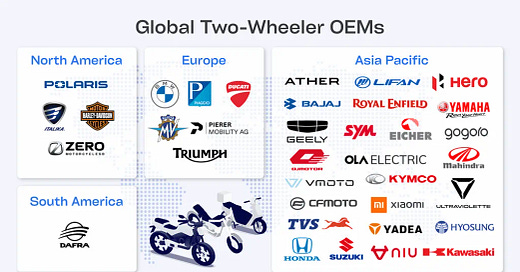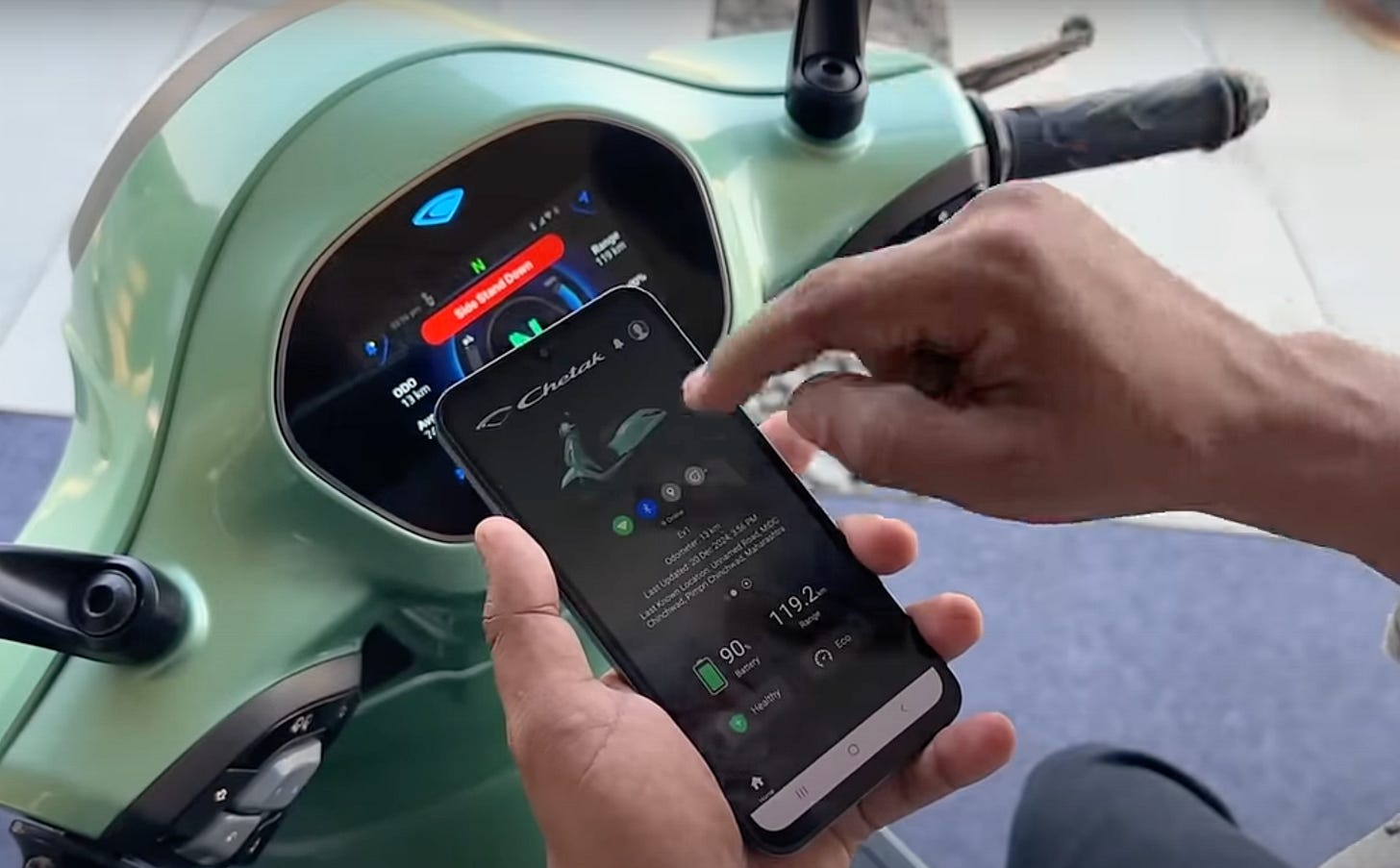Global Two-Wheeler Market Trends 2025: Electrification, Connectivity & Strategic Insights for OEMs
We explore the forces reshaping the global two-wheeler market—and what OEMs must do now to outpace disruption and capture sustainable value in 2025 and beyond.
On the go? Listen to this article instead:
The Two-Wheeler Market at a Strategic Inflection Point
The global two-wheeler industry is undergoing a structural transformation, driven by electrification, software-defined vehicle (SDV) architecture, and evolving consumer behavior. For consumers, it signals a new era of riding—where sleek urban EV scooters, smart off-roaders, and AI-enhanced touring bikes deliver more personalized, connected, and sustainable mobility experiences than ever before. For OEMs, this is not just a technology shift—it’s a full competitive realignment. Winning the race will depend on the ability to lead in data-enabled experiences, localized innovation, and scalable electrification.
Electrification: From Niche to Norm
Electric two-wheelers are no longer fringe contenders. As of 2023, EVs account for 13% of global two-wheeler sales, with China representing 78% of that volume. Major players like Yadea and NIU Technologies dominate through aggressive pricing, strong direct-to-consumer channels, and platform innovation.
Meanwhile, Honda—the global volume leader—has committed to 4 million electric unit sales annually by 2030, signaling the mainstreaming of electric mobility in the segment.
👉 Case in Point: Bajaj Chetak’s Market Surge
In India, Bajaj Auto’s electric Chetak scooter has seen exponential growth. As of March 2025, it led the Indian e-scooter segment with 34,863 monthly unit sales, capturing 29% market share. Its success was driven by:
The introduction of Chetak 2901 at a sub-₹1 lakh price point
A 123 km range and metal body durability
Expansion into smaller markets and new dealership growth
Innovation of first-in-class digital and connected features
Electrification, once seen as a long-term play, is now a short-term competitive differentiator in this segment. OEMs must recalibrate everything from their powertrain and battery tech to digital innovation portfolio investments to stay relevant.
Connectivity: Monetizing the Software Layer
By 2030, over 40% of new two-wheelers are projected to feature embedded connectivity. What began as infotainment is now expanding into:
Over-the-Air (OTA) updates
Telematics and real-time diagnostics
V2X Safety enhancements
Rider behavior analytics and personalized insights
📍 Bajaj’s “TecPac” Model
Bajaj’s TecPac—an optional flat fee software subscription—unlocks features like hill-hold assist, reverse mode, call/music control, custom ride modes, theft detection and more. This model exemplifies the emerging SaaS-like monetization of mobility, providing OEMs with:
Recurring revenue
Modular feature rollouts
Greater user stickiness and brand loyalty
For OEMs, software-defined two-wheelers will create new business models and demand tighter integration with cloud platforms, analytics tools, and mobile app ecosystems.
Regional Strategies: Localization Wins the Race
A global view reveals deeply fragmented preferences, reinforcing the need for regionally optimized strategies:
🌏 Asia
62% of global two-wheeler sales
India now leads in volume (18M+ units in FY2024)
Buyers prioritize affordability, practicality, and fuel economy
Growth driven by EV incentives and shared mobility use cases
🇪🇺 Europe
Premium, performance-oriented market (BMW Motorrad, Ducati)
Growing appetite for urban electric mobility
Regulatory pressure is accelerating EV adoption
🇺🇸 North America
Dominated by lifestyle brands (Harley-Davidson) but shifting
Honda now leads market share
Rising interest in electric cruisers and adventure bikes
🇧🇷 Latin America
Price-sensitive, dominated by Honda (72% share in Brazil)
Mexico’s Italika commands 50%+ with local assembly
Practical use cases drive adoption: delivery, commuting, fleet
The implication for OEMs here is that regional tailoring is not optional. Winning requires differentiated portfolios, pricing strategies, and marketing campaigns aligned to specific buyer behaviors.
Competitive Dynamics: Disruptors vs. Incumbents
Legacy OEMs such as Honda (32% global share), Hero MotoCorp (10%), and Yamaha (7%) maintain dominance via scale and brand trust. However, disruptors like Ola Electric and Yadea are rapidly outpacing traditional players in innovation cycles, cost structure, and digital-first engagement.
Emerging OEMs are:
Leveraging vertically integrated EV supply chains
Launching software-first, feature-unlock platforms
Bypassing dealerships with DTC models
Meanwhile, traditional OEMs must balance ICE model profitability with EV R&D, while embedding software agility into legacy frameworks.
Strategic Recommendations for OEMs
For OEMs, the path to leadership in the evolving two-wheeler market is not just about recognizing trends—it’s about translating them into actionable, future-proof strategies. The following priorities, rooted in market data and proven playbooks, offer a clear blueprint for sustained competitive advantage.
⚡ Accelerate Electrification
Target EV adoption aligned to projections of 40% new two-wheeler sales by 2030, with dedicated EV architectures and supply chain investment.
📡 Embed Advanced Connectivity
Think beyond infotainment—build full-stack SDV systems for diagnostics, OTA, safety, and rider personalization.
🌐 Localize Product Strategy
Back every regional market with quantitative insight: pricing, feature sets, distribution, and digital UX must be market-specific.
⚙️ Balance the Portfolio
Innovate on ICE to protect near-term margins, while progressively shifting R&D to EVs and SDVs.
🤝 Form Strategic Partnerships
Co-innovate with battery startups, cloud providers, and mobility tech players to accelerate roadmap execution and reduce cost-per-innovation.
Conclusion: The Road Ahead
The global two-wheeler market is no longer a volume race—it’s a race for software agility, electrification depth, and regional intimacy. OEMs that embrace a data-first, cloud-connected, customer-centric approach will not only survive this transition but define the next decade of two-wheeled mobility.
Those that don’t? Risk irrelevance in a market that’s evolving faster than ever.
Thanks for reading this week’s deep dive. Your thoughts? Let us know at editor@sdvinsider.com—we'd love to hear from you!
Until next time,
- SDV Insider Staff
Today’s Article is Brought to you by Sibros
Sibros delivers a complete connected vehicle platform purpose-built for software-defined two-wheelers and beyond. From real time data logging and over-the-air software updates to remote commands and diagnostics, Sibros helps OEMs unlock new value at every stage of the vehicle lifecycle. Get in touch with Sibros to learn more.







